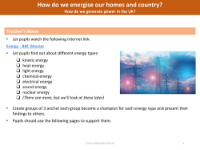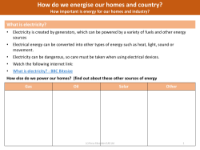How do we generate energy in the UK? - presentation

Geography Resource Description
In the United Kingdom, energy generation for powering homes and the country involves a diverse range of energy types. A presentation aimed at educating pupils delves into the various forms of energy, such as kinetic, heat, light, chemical, electrical, sound, and nuclear energy. Initially, students are encouraged to explore these energy types through an online resource provided by BBC Bitesize. They are tasked with learning about the characteristics of each energy type and how they contribute to our energy supply.
The presentation further explains that kinetic energy is possessed by all moving objects and is determined by an object's mass and velocity. Heat energy, often referred to as thermal energy, naturally transfers from warmer to cooler objects, which is a principle evident in simple scenarios like holding a hot mug of soup. Chemical energy is highlighted as the most utilised form by humans, as it is released through the digestion of food and is also stored in common fuels like wood, coal, oil, and gas. Sound energy is produced by vibrations and can travel through various mediums, except a vacuum, while light energy can travel even through a vacuum. Nuclear energy, released through the splitting or fusing of atoms, powers certain power stations, ships, and submarines, and is the energy source of the Sun. Lastly, electrical energy is generated by the movement of electrons, creating electricity as they flow through conductors. Students are encouraged to form groups and become champions for each energy type, presenting their findings to enhance their understanding of how these energies are harnessed to energise the UK.




